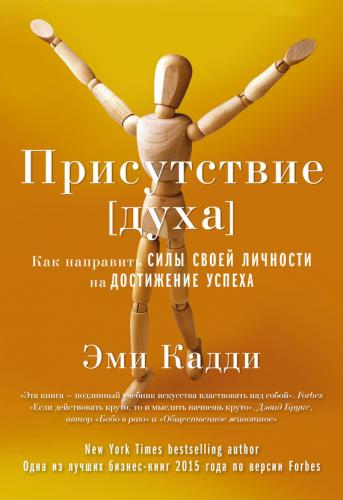21
Cuddy A. J. C., Wilmuth C. A. & Thornley N. Nonverbal presence signals believability in job interviews. Рукопись в процессе подготовки к печати.
22
Если хотите больше узнать об интроверсии, я очень рекомендую прочесть книгу Сьюзан Кейн (Susan Cain) Quiet: The Power of Introverts in a World That Can’t Stop Talking, New York: Crown (2013). Цит. по статье Elizabeth Bernstein, Wall Street Journal, 2015, August 24 «Why Introverts Make Great Entrepreneurs»: http://www.wsj.com/articles/ why-introverts-make-great-entrepreneurs-1440381699. (На рус. яз. книга выходила под названием «Интроверты: как использовать особенности своего характера».)
23
Узнать больше о том, как преднамеренное управление своим имиджем влияет на исход интервью, можно из следующих работ: Barrick M. R., Shaffer J. A. & DeGrassi S. W. (2009). What you see may not be what you get: Relationships among selfpresentation tactics and ratings of interview and job performance. Journal of Applied Psychology, 94, 1394–1411; Tsai W. C., Chen C. C. & Chiu S. F. (2005). Exploring boundaries of the effects of applicant impression management tactics in job interviews. Journal of Management, 31, 108–125; Gilmore D. C. & Ferris G. R. (1989). The effects of applicant impression management tactics on interviewer judgments. Journal of Management, 15, 557–564; Stevens C. K. & Kristof A. L. (1995). Making the right impression: A field study of applicant impression management during job interviews. Journal of Applied Psychology, 80, 587–606; Howard J. L. & Ferris G. R. (1996). The employment interview context: Social and situational influences on interviewer decisions. Journal of Applied Social Psychology, 26, 112–136; Baron R. A. (1986). Selfpresentation in job interviews: When there can be «too much of a good thing». Journal of Applied Social Psychology, 16, 16–28; Baron R. A. (1989). Impression management by applicants during employment interviews: The «too much of a good thing effect». In R. W. Eder & G. R. Ferris (Eds.), The employment interview: Theory, research, and practice. Newbury Park, CA: Sage Publications.
24
Marr J. C. & Cable D. M. (2014). Do interviewers sell themselves short? The effects of selling orientation on interviewers’ judgments. Academy of Management Journal, 57, 624–651.
25
Обзор см. в Kernis M. H. (2003). Toward a conceptualization of optimal selfesteem. Psychological Inquiry, 14, 1–26.
26
Обзор см. в Perkins A. M. & Corr P. J. (2014). Anxiety as an adaptive emotion. In G. Parrott (Ed.), The positive side of negative emotions. New York: Guilford Press.
27
Todd A. R., Forstmann M., Burgmer P., Brooks A. W. & Galinsky A. D. (2015). Anxious and egocentric: How specific emotions influence perspective taking. Journal of Experimental Psychology: General, 144, 374–391.
28
Jung C. G. (1962). An analysis of a prelude to a case of schizophrenia. Vol. 2 of Symbols of transformation. (R. F. C. Hull, Trans.). New York: Harper & Brothers.
29
Обзор стереотипов о лжецах см. в Hartwig M. & Bond C. F., Jr. (2011). Why do lie-catchers fail? A lens model meta-analysis of human lie judgments. Psychological Bulletin, 137, 643–659.
30
Henig R. M. (2006, February 5). Looking for the lie. The New York Times Magazine, 47–53.
31
Надо сказать, что исследователи из Университета Гранады обнаружили некоторые доводы в пользу того, что у лгущего человека повышается температура в области носа. Конечно, это не видно невооруженным глазом и поэтому не может считаться настоящим «эффектом Пиноккио». См. University of Granada (2012, December 3). Researchers confirm the «Pinocchio Effect»: When you lie, your nose temperature raises. Взято по адресу: http://canalugr.es/index.php / social– economicand-legal-sciences /item / 61182-researchers-confirm-the-«pinocchio-effect»-whenyou-lie-your-nose-temperature-raises.
32
Darwin C. (1872). The expression of the emotions in man and animals. Chicago: University of Chicago Press. (Цит. по Ten Brinke Leanne; Mac-Donald Sarah; Porter Stephen; O’Connor Brian. [2012]. Crocodile tears: Facial, verbal and body language behaviours associated with genuine and fabricated remorse. Law and Human Behavior, 36, 51–59.)
33
Ormerod T. C. & Dando C. J. (2014). Finding a needle in a haystack: Toward a psychologically informed method for aviation security screening. Journal of Experimental Psychology: General 144, 76–84.
34
Ten Brinke et. al., Crocodile tears, 52.
35
Ekman P. (2009). Telling lies: Clues to deceit in the marketplace, politics, and marriage (Revised ed.). New York: W. W. Norton & Company.
36
Ten Brinke et. al., Crocodile tears, 51.
37
Чарльз Бонд и Белла Депауло проанализировали ответы почти двадцати пяти тысяч опрошенных и обнаружили, что люди отличают правду от лжи примерно в 54 % случаев – это немногим точнее, чем просто подбрасывать монету. Это открытие согласуется
